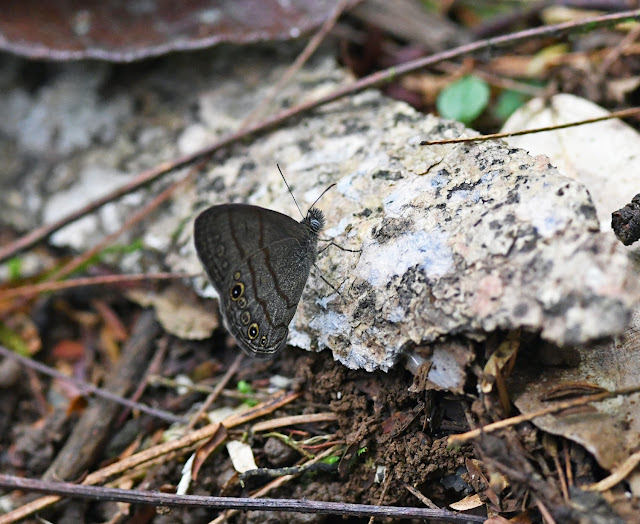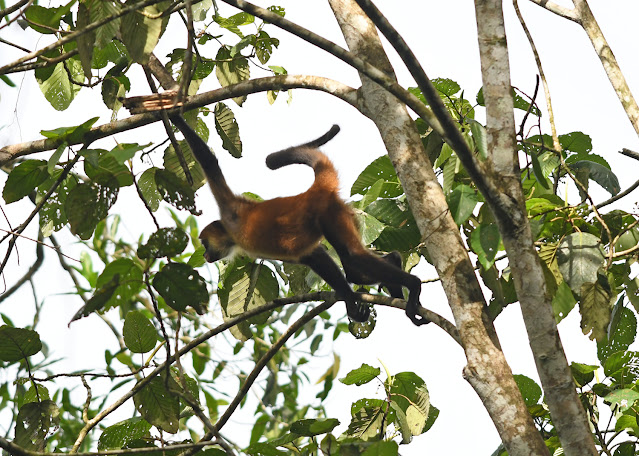----------
The La Selva Biological Station occupies over 1500 hectares of lowland tropical rainforest in northeastern Costa Rica. Operated by the Organization for Tropical Studies, it hosts upwards of 300 scientists and 100 field courses each year and is one of the most prolific field stations in the world.
La Selva is also a popular destination for visiting birders and naturalists. While La Selva's primary goal is to protect the primary forest and to provide facilities to enable forest research, it is also possible for ecotourists to book rooms and stay here. The price is relatively reasonable compared to nearby ecolodges, though one has to keep in mind that it is a field station and not a fancy ecolodge.
One advantage that the La Selva Biological Station holds over nearby lodges (such as the Selva Verde Lodge that we had just stayed at) is that visitors are allowed to explore the forest without having to hire a guide. This is one of the main reasons why Laura and I decided to book two nights here with my parents.
 |
| Strawberry Poison Dart Frog (Oophaga pumilio) - La Selva Biological Station, Heredia, Costa Rica |
An extensive trail system snakes throughout much of the protected forest. Many of the trails close to the station's buildings have been built with concrete, while other trails further from the station consist of standard dirt trails. Some trails are off-limits to non-researchers but even still, it is possible to spend several days here, exploring different locations each day.
Personally, I was quite interested in visiting La Selva for a number of reasons. Primarily of course was the chance to explore lowland primary rainforest; an experience that I savour every time. But second, I was also hoping to catch up with some bird species that I had never seen before. There were a few main species I had on my mind, and these included Slaty-breasted Tinamou, Semiplumbeous Hawk, Snowy Cotinga, Canebrake Wren and Nicaraguan Seed-Finch. I also had a chance of seeing a few other, more widespread species such as Short-tailed Nighthawk, Agami Heron and Black-cowled Oriole. And finally, there were potential lifers that are rare and not expected at La Selva, including the Bare-necked Umbrellabird and Gray-headed Piprites.
 |
| Collared Peccary - La Selva Biological Station, Heredia, Costa Rica |
We pulled into the station around noon and were given a brief orientation and instructions. Our accommodations would be a large, two bedroom cabin set at the edge of a clearing adjacent to the forest, and only a two minute walk to the main station and dining area. Not a bad spot!
Upon dropping off our bags, Laura and I set off on the trails. The birding was relatively slow as expected given the time of day but we had a few nice sightings.
The above-pictured Collared Peccaries were feeding quietly at the edge of one of the concrete trails. Not expecting to see this species so well, Laura and I were thrilled to watch and photograph a group of them.
 |
| Collared Peccary - La Selva Biological Station, Heredia, Costa Rica |
It turns out that the peccaries are a mainstay along the trails and in clearings at La Selva. Not a rare sighting at all, though they are awfully cute!
 |
| Collared Peccary - La Selva Biological Station, Heredia, Costa Rica |
We found a trail that was completely devoid of visitors and ventured deep into the forest. Our footsteps were nearly silent, a function of the concrete pathway covered in a light layer of moss. While the forest was quiet, occasionally something would catch our attention. A branch breaking in the understorey here, a flutter of wings over there, perhaps a bird vocalization from afar. A Green Ibis was foraging along the trail but it saw us first. We watched it fly away from us and dart into the mid-story of the forest. Later, one was seen curiously watching us from its arboreal perch.
 |
| La Selva Biological Station, Heredia, Costa Rica |
We flushed a cryptically patterned bird on a little-used trail and I immediately recognized it as a Short-tailed Nighthawk due to its rich brown colour and lack of white patches in the wings. It landed somewhere in the forest. A few minutes of active searching ensued, and the bird flushed again - confirming the field marks I had earlier seen. Unfortunately, that was all we would get...
 |
| Hermes Satyr (Hermeuptychia hermes) - La Selva Biological Station, Heredia, Costa Rica |
Eventually Laura turned back since we had already walked quite a ways. It was time for a mid-afternoon nap. I pressed on.
A familiar sound caught my ear - the crackling of branches and swishing of leaves that can only be caused by monkeys swinging through the trees. Stealthily, I peeked through the lush foliage and watched the group of Central American Spider Monkeys until they were gone, behind layers of green.
 |
| Central American Spider Monkey - La Selva Biological Station, Heredia, Costa Rica |
Later that afternoon I returned to the cabin, eager to meet up with everyone else and explore with them. On the way back I had heard the eery vocalizations of several Slaty-breasted Tinamous, a sound that is reminiscent of a train whistle. We would hear this species early every morning and late every evening, though we never actually saw one!
As afternoon transformed into evening I joined Laura and my parents for a walk around the property. The temperatures had cooled slightly and the bird activity was quite high! Just in the area around the buildings we found a few nice birds, some of which were new for my parents. Three species of toucan and two species of oropendola teed up on the tall trees around the clearing, while we managed excellent looks of a number of tanagers, flycatchers, and seedeater types.
 |
| Keel-billed Toucan - La Selva Biological Station, Heredia, Costa Rica |
The Río Puerto Viejo runs just a few dozen meters from the main buildings on the research station, while the extensive trail system begins on the far side of the river. A swing bridge has been constructed to access these areas, and it was here where we spent part of the last hour of daylight.
 |
| Río Puerto Viejo - La Selva Biological Station, Heredia, Costa Rica |
Rivers are always excellent places to spend time if one is searching for wildlife. Turtles and crocodilians bask on exposed banks and logs, mixed flocks of birds move up and down the river corridor, and species like cotingas can often be seen perching on dead snags and at the tops of trees. Perhaps, if one is extraordinarily lucky, a rare mammal may be seen along the banks or swimming across the watercourse.
I was really hoping to find a Snowy Cotinga here as it was one of my main targets. Unfortunately, we would not be lucky this evening but we still enjoyed many other species. Vaux's Swifts and migrant Ciff Swallows coursed overhead, several Black River Turtles were trying to catch the last rays of the day, more Keel-billed Toucans entertained us with their antics, and a few small flocks of songbirds passed through. This Olive-backed Euphonia was my first for Costa Rica.
 |
| Olive-backed Euphonia - La Selva Biological Station, Heredia, Costa Rica |
That evening we enjoyed a hearty dinner before heading back out to the trails. We were all a little tired and so only stayed out for an hour or so. We had noticed earlier that the forest was pretty dry, with no recent evidence of rainfall. This hampered our night hike efforts and we found almost zero herps. At least there were numerous interesting invertebrates to keep us occupied.
 |
| Fidicina mannifera - La Selva Biological Station, Heredia, Costa Rica |
 |
| Yellow-edged Ruby-Eye (Orses cynisca) - La Selva Biological Station, Heredia, Costa Rica |
 |
| Rhynchacris sp. - La Selva Biological Station, Heredia, Costa Rica |
 |
| Unidentified orbweaver - La Selva Biological Station, Heredia, Costa Rica |
 |
| Savage's Thin-toed Frog (Leptodactylus savagei) - La Selva Biological Station, Heredia, Costa Rica |
 |
| Wood Thrush - La Selva Biological Station, Heredia, Costa Rica |








































